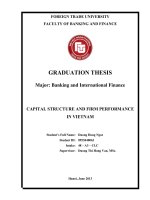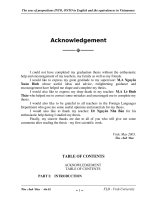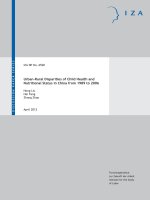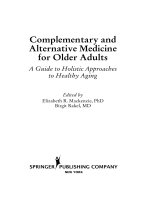Sleep disturbances and frailty status in older adults in vietnam
Bạn đang xem bản rút gọn của tài liệu. Xem và tải ngay bản đầy đủ của tài liệu tại đây (363.97 KB, 6 trang )
JOURNAL OF MEDICAL RESEARCH
SLEEP DISTURBANCES AND FRAILTY STATUS
IN OLDER ADULTS IN VIETNAM
Nguyen Trung Anh1,2, Nguyen Thi Ngoc Anh², Dang Thi Xuan³ và Nguyen Xuan Thanh1,2,
¹National Geriatric Hospital
²Hanoi Medical University
³Vietnam Poison Control Center
This cross-sectional study aimed to describe sleep disturbance and its association with frailty syndrome
among 903 older adults at the National Geriatric Hospital in Vietnam. Frailty was diagnosed according to the
Fried criteria. Sleep disturbances was assessed based on the Pittsburgh Sleep Quality Index (PSQI). Of 903
patients, the mean age was 71.8 (SD = 8.5), and 537 (59.5%) were female. Most (96.7%) of the patients
diagnosed with frailty had poor sleep; 95.3% had to get up at midnight or early morning; 93.3% could not sleep
within 30 minutes; 86% had sleep efficiency less than 85%; 53.3% coughed at night; 50.7% had nightmares;
and 27.3% and 22.7% of patients felt hot and cold, respectively. The majority (80.0%) of patients must get up
to use the bathroom. In conclusion, most older adult diagnosed with frailty experienced at least one form of of
sleep disturbance. Medical staffs should attend to the patient’s sleep quality, especially in patients with frailty.
Keywords: Sleep disturbance, older adults, frailty
I. INTRODUCTION
Frailty is a public health problem with a
prevalence of about 10.7% in the communitydwelling elderly population.¹ In Vietnam, among
the hospitalized elderly, the prevalence of
pre-frailty and frailty are 39.8% and 33.8%,
respectively.¹ Frailty older adults are at
increased risk of premature death and various
negative health outcomes, including falls,
fractures, disability, and dementia, all of which
could result in poor quality of life, increased
cost and use of health care resources, such as
emergency department visits, hospitalization,
and institutionalization.2-4
Sleep disturbances are common and
Corresponding author: Nguyen Trung Anh,
Hanoi Medical University
Email:
Received: 15/03/2021
Accepted: 20/05/2021
JMR 141 E8 (5) - 2020
serious problems of the elderly population.5,6 A
2017 study reported that 28.2% of Vietnamese
elderly have sleep quality disorder.⁷ Sleep
is extremely important to health since the
human body carries out a series of necessary
biological and physiological activities during
the sleep process, such as hormonal release,
energy metabolism, glucose and cardiovascular
regulation, and self-regulation and recovery of
physiological functions.⁸
In the world, many studies about sleep
disturbances in frailty patients had been
conducted and indicated that sleep disturbance
was associated with both prevalence and
incidentce of frailty among elders. Prior
studies showed that the prevalence of sleep
disturbances among elders with frailty was
61% and increased with age, smoking, alcohol
intake and some medications. Recently, poor
sleep quality and sleep duration were reported
69
JOURNAL OF MEDICAL RESEARCH
to be associated with prevalence and incidence
of frailty.
Understanding about prevalence of sleep
disturbances in frailty patients is highly important
managing sleep disturbances and reducing its
effect on hospitalization. However, there is so
difficulty to find a significant research in Vietnam
about this problem. Therefore, we performed
this research to describe sleep disturbance
and its association with frailty syndrome among
older adults.
(4) Slowness; (5) Low physical activity level.
The Pittsburgh Sleep Quality Index (PSQI)
was used to assess sleep disturbance. The PSQI
score was calculated by summing the points of
seven components: (1) Subjective sleep quality;
(2) Sleep latency; (3) Sleep duration; (4) Sleep
efficiency; (5) Sleep disturbance; (6) Use of
sleep mediation; and (7) Daytime dysfunction.
If a participant had a PSQI score of ≥ 5, that
participant was considered to have poor sleep.
II. METHODS
Data were coded and entered into REDCap
software. Analysis was conducted using SPSS
version 22 software. Descriptive statistics
were reported as number, percentage, mean
and SD. Statistical significance was presented
with p-value which is less than 0.05.
1. Research subjects
903 patients aged 60 and older from the
National Geriatric Hospital in Vietnam.
The inclusion criteria were: (1) 60 years
old or older and (2) conscious and have the
ability to communicate and perform physical
tests. Patients who refused to participate or
were diagnosed with acute diseases such as
stroke, meningitis, encephalorrhagia, etc. were
excluded from this study.
2. Method
Study design: This was a cross-sectional
study
Variables and Data Processing: Participants
were interviewed for 20 - 30 minutes. A
questionnaire was used to collect demographic
data, including age, gender (male or female),
educational level (illiterate, primary school,
secondary school or higher education), marital
status (married, single, widowed, or divorced),
and living area (rural area or urban area).
Frailty was defined by Fried’s frailty criteria
as having 3 or more of the following 5 crieria⁹: (1)
Shrinking; (2) Weakness; (3) Poor endurance;
70
3. Data analysis
4. Ethics
All data collected was used for research to
improve quality of senior health care service.
III. RESULTS
1. Characteristics of the participants
Of the 903 participants , 59.5% (537/903)
were female and 40.5% (366/903) were male;
the ratio of female/male was 1.47. The mean
age of the participants was 71.8 years old (SD =
8.5; range: 60 – 98). The percentage of married
participants was 76.5%, which was triple the
percentage of unmarried, divorced or widowed
participants (23.5%). About 57.4% (519) had
secondary school and below education, 24.4%
(220) graduated from high school and 18.2%
(164) continued education beyond high school.
Only 7 participants (4.7%) with frailty had
education beyond high school.
JMR 141 E8 (5) - 2020
JOURNAL OF MEDICAL RESEARCH
Table 1. Patients Demographics (n = 903)
Characteristics
N
Age (Mean ± SD)
Gender
Marital status (missing 3)
Living area (missing 10)
Educational level (missing 2)
%
71.8 ± 8.5
Male
366 (40.5)
40.5
Female
537 (59.5)
59.5
Married
689 (76.5)
76.5
Single/Widowed/ Divorced
211 (23.5)
23.5
Rural living
403 (45.1)
45.1
Urban living
491 (54.9)
54.9
Secondary school and below
519 (57.4)
57.4
High school
220 (24.4)
24.4
College/university and above
164 (18.2)
18.2
2. Prevalence of sleep disturbance in frailty
patients
Figure 1 The prevalence sleep disturbance
in frailty older adults (n = 903)
Figure 1 presented the prevalence of sleep
disturbance experienced by the participants in
the prior month, stratified by frailty status. The
majority of the participants (85.7%, 774/903)
reported having poor sleep. Among participants
with frailty, 96.7% (145/150) reported having
poor sleep.
3. PSQI score results
JMR 141 E8 (5) - 2020
Figure 2. The percentage of sleep latency
(n = 903)
Almost all frailty participants (93.3%,
140/150) could not fall asleep within 30, and the
majority (76.4%) of non-frailty reported having
the same problem.
Sleep efficiency was calculated by the
following formula:
Sleep efficiency = (total of hours asleep)/
(total of hours in bed) ×100
Only 14.0% (21/150) and 32.0% of frailty
and non-frailty participants had sleep efficiency
of more than 85%, respectively.
71
JOURNAL OF MEDICAL RESEARCH
Figure 3. The percentage of sleep efficiency (n = 903)
During sleep, frailty participants were significantly more likely than non-frailty participants to get up
at midnight or early morning, get up to use the bathroom, feel pain, feel hot, cough, have nightmare,
and experience difficulty breathing.
Table 2. The characterisitcs of sleep disturbances (n = 903)
Classification
Frailty (N = 150)
Non- frailty (N = 753)
p
Getting up at midnight or early morning
143 (95.3)
618 (82.1)
< 0.001
Getting up to use bathroom
120 (80.0)
505 (61.9)
< 0.001
Feeling pain
118 (78.7)
341 (45.3)
< 0.001
Coughing
80 (53.3)
348 (46.2)
< 0.001
Having nightmare
76 (50.7)
209 (27.8)
< 0.001
Feeling difficult to breath
66 (44.0)
277 (36.8)
< 0.001
Feeling cold
34 (22.7)
127 (16.9)
0.18
Feeling hot
41 (27.3)
130 (17.3)
0.01
Other
12 (0.08)
28 (0.04)
0.32
IV. DISCUSSION
On average, the frailty participants in our
study were older than non-frailty participants
(78.4 ± 9.0 vs. 71.8 ± 8.5). This finding is similar
to a previous study in Ecuador, in which the
average age of the participants was 71 years
old (SD = 8) and 76 years old (SD = 9) in frailty
participants.10 We observed a higher proportion
of women among our participants (59.5%
compared to 40.5% for men). Other studies
conducted in China and Ecuador similarly
had more women than men among their
72
participants.10,11 In said studies, the prevalence
of frailty was significantly higher among women
compared to men, with 69.2% and 70% of the
frailty participants were women in China and
Ecuador, respectively.10,11 The prevalence of
female in frailty participants slightly increased
of the community. This characteristic may be
explained by the greater physiological muscle
mass loss experienced by women as they age;
in addition women are more prone to have
sarcopenia, an intrinsic risk for developing
frailty syndrome.12
JMR 141 E8 (5) - 2020
JOURNAL OF MEDICAL RESEARCH
Most of our participants reported having
poor sleep (85.7%), and among the frailty
participants, almost all (96.7%) reported having
poor sleep. Both observations were higher
compared to proportions reported by Sun el
al. in China (56.1%) and Ensrud et al. in the
United States (61.0%),11,13 although the sample
size in our study was smaller. Almost all frailty
participants (93.3%) could not fall asleep within
30 minutes, while this prevalence in China
was just 37.9%.11 Only 14.0% of our frailty
Association between frailty and quality of life
among community-dwelling older people: a
systematic review and meta-analysis. Journal
of epidemiology and community health. 2016;
70(7): 716-721.
3. Kojima G, Liljas AEM, Iliffe S. Frailty
syndrome: implications and challenges for
health care policy. Risk Manag Healthc Policy.
2019; 12: 23-30.
4. Xue QL. The frailty syndrome: definition
and natural history. Clinics in geriatric medicine.
participants had sleep efficiency of more than
85%, much lower than the 43.6% reported by
Sun et al. in China.11 The relationship between
sleep disturbances and frailty status might be
mediated through some mechanisms. Sleep
disorders may be a marker of a number of
conditions including poor health and comorbidities (cardiovascular disease, depressive
symptoms, cognitive dysfunction, and functional
disabilities), which by themselves impair sleep
and increase the likelihood of greater frailty
status. Besides, sleep disturbances and frailty
or its components have both been linked to
alterations in biochemical pathways including
lower
endogenous
testosterone
levels,
reduced renal function, and elevations in proinflammatory cytokines.13
2011; 27(1): 1-15.
5. Kurina LM, McClintock MK, Chen JH,
Waite LJ, Thisted RA, Lauderdale DS. Sleep
duration and all-cause mortality: a critical review
of measurement and associations. Annals of
epidemiology. 2013; 23(6): 361-370.
6. Mannion H, Molloy DW, O'Caoimh R.
Sleep Disturbance in Older Patients in the
Emergency Department: Prevalence, Predictors
and Associated Outcomes. International journal
of environmental research and public health.
2019; 16(19).
7. Le Dinh D, Thuong NH. Cognitive
impairment and sleeping disorder among the
elderly at communities in Hue city, Vietnam.
2017.
8. Van Cauter E, Spiegel K, Tasali E, Leproult
R. Metabolic consequences of sleep and sleep
loss. Sleep medicine. 2008; 9 Suppl 1(0 1):S2328.
9. Bieniek J, Wilczyński K, Szewieczek J.
Fried frailty phenotype assessment components
as applied to geriatric inpatients. Clinical
interventions in aging. 2016;11: 453-459.
10. Del Brutto OH, Mera RM, Sedler MJ, et
al. The Effect of Age in the Association between
Frailty and Poor Sleep Quality: A Population-Based
Study in Community-Dwellers (The Atahualpa
Project). Journal of the American Medical Directors
Association. 2016; 17(3): 269-271.
V. CONCLUSION
The prevalence of sleep disturbance
among frailty older adult was extremely high
in our study. Medical staffs should pay greater
attention to sleep quality in frailty patients.
REFERENCES
1. Vu HTT, Nguyen TX, Nguyen TN, et al.
Prevalence of frailty and its associated factors
in older hospitalised patients in Vietnam. BMC
Geriatr. 2017; 17(1): 216.
2. Kojima G, Iliffe S, Jivraj S, Walters K.
JMR 141 E8 (5) - 2020
73
JOURNAL OF MEDICAL RESEARCH
11. Sun XH, Ma T, Yao S, et al. Associations
of sleep quality and sleep duration with frailty
and pre-frailty in an elderly population Rugao
longevity and ageing study. BMC Geriatrics.
2020; 20(1): 9.
12. Espinoza SE FL. Risk factors for frailty in
74
the older adult. Clin Geriatr Med. 2007: 15 - 37.
13. Ensrud KE, Blackwell TL, Redline S,
et al. Sleep disturbances and frailty status in
older community-dwelling men. Journal of the
American Geriatrics Society. 2009; 57(11): 20852093.
JMR 141 E8 (5) - 2020









